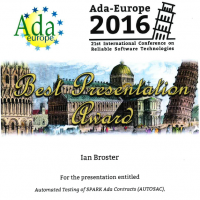The renames facility is just one of a long list of reasons why we are big Ada fans. Here I explain how the renames facility works and how it can help you write code which is both readable and traceable.
Within the Ada community, one of the guiding principles is tracing items to their source. For example if you are referencing item Gross_Weight from Vegetable.Potato and Fruit.Apple. then you could write:
Basket := Vegetable.Potato.Gross_Weight(PotatoCount) + Fruit.Apple.Gross_Weight(AppleCount);
This unambiguously indicates the origin of the referenced items. However with the use of meaningful labels (e.g. Exhaust_Temperature rather than ETemp) code can on occasions get somewhat verbose. The initial reaction to this is to make use of use clauses which would allow – assuming the overload can be resolved:
Basket := Gross_Weight(PotatoCount) + Gross_Weight(AppleCount);
This is however discouraged as the benefit of traceability is considered to significantly outweigh brevity. Use clauses are by common agreement “a bad thing”. The alternative is to use renames which give a shorthand method of referencing items while retaining traceability e.g.:
declare
function Apple_Weight return KILOS renames Fruit.Apple.Gross_Weight;
function Potato_Weight return KILOS renames Vegetable.Potato.Gross_Weight;
begin
Basket := Apple_Weight(AppleCount) + Potato_Weight(PotatoCount);
end;
Another important principle to apply here is that renames should generally be limited to the minimum possible scope. This adheres to the traceability philosophy of the Ada community.
Another use of renames is to partially evaluate the name of an object. Consider the following code snippet:
type PERSONNEL_TYPE is record
Employee_Num : EMPLOYEE_NUM_TYPE;
Join_Date : DATE_TYPE;
Birthday : DATE_TYPE;
end record;
type WORKFORCE_TYPE is array (EMPLOYEE_NUM_TYPE) of PERSONNEL_TYPE;
procedure Check_Birthday ( Workers : WORKFORCE_TYPE;
Today : DATE_TYPE ) is
begin
for I in Workers'range loop
if Workers(I).Birthday.Day = Today.Day and
Workers(I).Birthday.Month = Today.Month
then
Send_Card (Worker => Workers(I),
Age => Today.Year – Workers(I).Birthday.Year);
end if;
end loop;
end;
As can be seen the body of the loop has to restate the “Workers(I).Birthday” for each element Day/Month/Year of the record. Again a small rewrite could give:
for I in Workers'range loop
declare
DoB : DATE_TYPE renames Workers(I).Birthday;
begin
if DoB.Day = Today.Day and
DoB.Month = Today.Month
then
Send_Card ( Worker => Workers(I),
Age => Today.Year - DoB.Year );
end if;
end ;
end loop;
Older Ada programmers will be familiar with rename constructs such as:
with P1;
function "+" (Left, Right : P1.MY_INTEGER)
return P1.MY_INTEGER renames P1."+";
which were necessary to gain visibility of the operator for MY_INTEGER from package P1 in the absence of a use clause. The alternative was the extremely cumbersome:
Var := P1.”+” ( Var1, Var2);
They will also painfully remember the following error when adding extra operators in to code:
function "+" (Left, Right : P1.MY_INTEGER)
return P1.MY_INTEGER renames P1."+";
function "*" (Left, Right : P1.MY_INTEGER)
return P1.MY_INTEGER renames P1."+";
The multiply operator has been added by cut and paste but the rename is still of the “+” operator. Fortunately Ada 95 has pragmatically implemented the “use type” clause, thus:
with P1; use type P1.MY_INTEGER;
will give visibility to all the primitive operators associated with MY_INTEGER, while the types and objects still need disambiguation, there is no doubt where the operators are inherited from.
The rename facility of the Ada language gives a useful shorthand notation for accessing objects. Judgment must be used when to use this feature – the above examples are all fairly trivial; real world instances are likely to have more benefit. In conclusion it can be seen that renames can significantly enhance readability while at the same time retain traceability and avoid the need for use clauses.

 Rapita System Announces New Distribution Partnership with COONTEC
Rapita System Announces New Distribution Partnership with COONTEC
 Rapita partners with Asterios Technologies to deliver solutions in multicore certification
Rapita partners with Asterios Technologies to deliver solutions in multicore certification
 SAIF Autonomy to use RVS to verify their groundbreaking AI platform
SAIF Autonomy to use RVS to verify their groundbreaking AI platform
 What does AMACC Rev B mean for multicore certification?
What does AMACC Rev B mean for multicore certification?
 How emulation can reduce avionics verification costs: Sim68020
How emulation can reduce avionics verification costs: Sim68020
 Multicore timing analysis: to instrument or not to instrument
Multicore timing analysis: to instrument or not to instrument
 How to certify multicore processors - what is everyone asking?
How to certify multicore processors - what is everyone asking?
 Certifying Unmanned Aircraft Systems
Certifying Unmanned Aircraft Systems
 DO-278A Guidance: Introduction to RTCA DO-278 approval
DO-278A Guidance: Introduction to RTCA DO-278 approval
 ISO 26262
ISO 26262
 Data Coupling & Control Coupling
Data Coupling & Control Coupling
 DASC 2025
DASC 2025
 DO-178C Multicore In-person Training (Fort Worth, TX)
DO-178C Multicore In-person Training (Fort Worth, TX)
 DO-178C Multicore In-person Training (Toulouse)
DO-178C Multicore In-person Training (Toulouse)
 HISC 2025
HISC 2025



















